
ARTS & CRAFTS SOCIETIES IN CANADA
WILLIAM MORRIS SOCIETY OF CANADA
87 Government Road, Toronto , Ontario , M8X 1W4
Tel. 416-233-7686
info@wmsc.ca
www.wmsc.ca
ORIGIN & HISTORY OF THE ARTS & CRAFTS MOVEMENT IN CANADA
About Paul Beau (1871-1949)
One of the few Canadians who was able to devote his career to the execution of his own hand work was Paul Beau, a metal craftsman from Montreal . Paul Beau was born in Montreal , November 1, 1871 . He began his career as a dealer in antiques and watches. After 1906, Paul Beau & Co. refer to themselves as Artistic Metal Workers offering Antique Art Goods, Old Clocks, Ancient Arms, Brass and Copper Jardinieres. He maintained a shop and residence from 1915 - 1922 at 291 Mountain Street in Montreal .
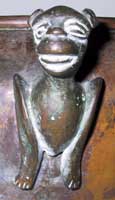 Paul Beau was part of the Arts and Crafts movement in Canada . With the onset of cheap and rapid methods of machine manufacture in the applied arts, quick profits quickly outweighed the respect and demand for the craftsman-artist. Beau refused to rely on machines and worked in the tradition of the early European metalsmiths. Paul Beau was part of the Arts and Crafts movement in Canada . With the onset of cheap and rapid methods of machine manufacture in the applied arts, quick profits quickly outweighed the respect and demand for the craftsman-artist. Beau refused to rely on machines and worked in the tradition of the early European metalsmiths.
A characteristic feature of Beau's works is the combination of metals of contrasting colours, such as employing brass for the body of an object and trimming it with decorative bands of red copper. The style of Beau's works would vary from jardiniere of Gothic inspired motifs, or an urn of classical shape ornamented with Greek geometric patterns, to a letter box with embossed naturalistic leaves after British arts and crafts design. Beau was fond of adding ornate, cast brass plaques or handles and feet to his pieces, while keeping the main body of the piece as simple as possible. Often, Beau would treat the brass with chemicals to produce a dark brown shiny patina which was intended to give the piece an antique look. This antique or bronzed appearance was admired by Beau's clients and often preferred to the bright lustre of new brass.
To identify his work, Paul Beau usually, but not always, stamped the metal with his mark: PAUL BEAU & Co/MONTREAL within a circle. This is the most common form of his mark but some pieces (late 1920's to the 1940's when Beau no longer ran his shop) are known to simply bear the name, PAUL BEAU.
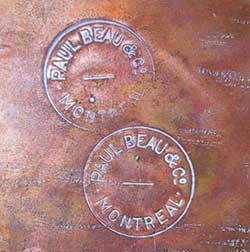 Paul Beau received some recognition for his first architectural commissions from the Montreal firm of Edward and William S. Maxwell. The Maxwell brothers were responsible for many domestic residences and public buildings in Montreal including hotels, railway stations and civic buildings in other Canadian cities. According to the architects' record books, Paul Beau executed on a regular basis from 1903 to 1916, creating electric fixtures, fireplace accessories, door hardware, wrought-iron grilles, lanterns and even weather vanes for the Maxwells' buildings. As a result of his reputation as a metalsmith, Paul Beau was commissioned to undertake the ornamental hand-wrought ironwork in the Centre Block of the Federal Parliament Buildings in Ottawa . For Paul Beau, this Ottawa commission was the high point in his career. Paul Beau received some recognition for his first architectural commissions from the Montreal firm of Edward and William S. Maxwell. The Maxwell brothers were responsible for many domestic residences and public buildings in Montreal including hotels, railway stations and civic buildings in other Canadian cities. According to the architects' record books, Paul Beau executed on a regular basis from 1903 to 1916, creating electric fixtures, fireplace accessories, door hardware, wrought-iron grilles, lanterns and even weather vanes for the Maxwells' buildings. As a result of his reputation as a metalsmith, Paul Beau was commissioned to undertake the ornamental hand-wrought ironwork in the Centre Block of the Federal Parliament Buildings in Ottawa . For Paul Beau, this Ottawa commission was the high point in his career.
In the 1940's, Beau was in his seventies and found little demand for his work. Metal was scarce due to the war when copper and brass were needed for bombs and ammunitions rather than decorative metal artwares. In his seventy-eighth year, a forgotten artist and in a difficult financial position, Paul Beau took his own life under the large cross atop Mount Royal overlooking Montreal .
By Cameron Freeman
The Arts and Crafts Movement in Victoria , British Columbia
Introduction
A Background for the Arts and Crafts Movement
In England and then America in the late 19th century, a middle class revolution occurred against Victorian values, industrialization and the mass production of low-quality products. Originally a British movement whose roots can be traced back to the early 1800's, the social and moral preachings of people such as John Ruskin and William Morris in the late 1800's influenced the burgeoning what would be known as the Arts and Crafts Movement.
The philosophy behind the Arts and Crafts Movement was recognition that technology, or industrialization, did not equate to a higher quality of life for individuals. The Arts and Crafts Movement believed that the degradation of social values, which was evident through poor working conditions, poverty and the exploitation of workers, was caused by wide-spread industrialization (Naylor, pg. 7).
By 1880, the Arts and Crafts Movement became the symbol for the "liberal middle class" (Anscombe, pg. 54). The movement strove to make art affordable to all people, create better working conditions, and influence a climate where artists who ranged from architects to those involved in the fine arts, were free to be creative. In the new society which the Arts and Crafts Movement hoped to influence, artists could design and create each piece of work from start to finish. Pieces would be hand-made and of the best quality.
Because of its strive for universal accessibility to art, the movement was considered to be closely allied with socialism in its dictate that "honest craftsmanship is good for both the craftsman and the inhabitant of a 'reformed' home" (Anscombe, pg. 56). The Arts and Crafts Movement focused on personal aesthetics and the individual. In these aesthetic values, the movement believed that society produced the art and architecture in which it deserves (Callen, pg. 2).
Ironically, by the end of the Arts and Crafts Movement in the first quarter of the 20th century, the products of the movement became so expensive that only the wealthy could afford them.
Arts and Crafts Movement in America
Although influenced by many of the same writings and beliefs of the Arts and Crafts Movement in England , the movement in America was housed within the context of the post-war reconstruction in the United States and the settlement and development of new territories (Anscombe, pg. 63).
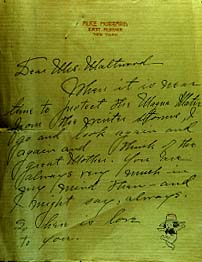
Letter to Maltwood from A.Hubbard
|
During this time around the turn of the century, the Arts and Crafts Movement was most prevalent in the Eastern and Mid-United States . One of the most influential individuals in this movement was Gustav Stickley who designed and built functional furniture in Chicago . Stickley published the periodical, the Craftsman which had wide-distribution over North America and influenced the stylistic choices of many households.
Another influential publication of the Arts and Crafts movement in America was the Fra, published by Elbert Hubbard. The Fra, like the Craftsman, preached the positive values of owning a home designed by known Arts and Crafts architects and furnishing and decorating it appropriately. Hubbard founded the Roycroft artistic community in East Aurora , New York which was one of the most successful Arts and Crafts communities in the United States and produced commodities ranging from books to furniture to its famous copper pieces. |
Many other important artists and groups contributed to the development and prominence of the Arts and Crafts Movement in the United States . Individuals such as Louis Comfort Tiffany and groups such as the Rookwood and Van Briggle Pottery Companies have a legacy which is visible in collections as far north and west as that of Katharine Emma Maltwood of Victoria, British Columbia.
Collection of Katharine Maltwood and the Maltwood Art Museum and Gallery
Katharine Maltwood, an English sculptress and antiquarian, had a life-long involvement in the Arts and Crafts Movement. In 1911, Maltwood completed a sculptural commission called the Magna Mater for Alice and Elbert Hubbard, the founders of the Roycroft Institute and editors of the Fra. The Maltwood's personal collection, which was bequested to the Maltwood Art Museum and Gallery , contains a large number of Arts and Crafts pieces ranging from Roycroft copper pieces, Earthenware from Van Briggle, Weller and Rookwood Pottery Companies to numerous silver pieces, oak furniture and a Tiffany leaded stainglass lamp. |
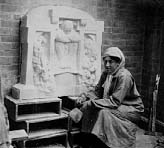
Sculpting the
Magna Mater
|
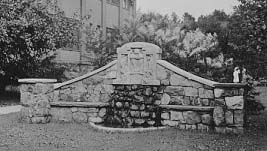
The Magna Mater at the Roycroft Institute
Katharine Maltwood and her husband, John, believed in surrounding themselves with beautiful objects and in this way, they were following the ideas of Morris and the Arts and Crafts Movement (Brown, pg. 45). When the Maltwoods moved to Victoria from England in 1938, Katharine began working towards developing a museum of their collection to donate to the city. She chose a Tudor revival house and named it "The Thatch". In renovating it to reflect a country home only the best quality materials were used. "The Thatch" was "evidence of the handcraftmanship [of] the Arts and Crafts principle of natural expression of material and structure (Brown, pg. 47). The Maltwood Art Museum and Gallery has continued with Katharine's life-long interest in the Arts and Crafts Movement.
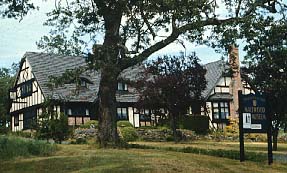
The Thatch
Roycroft Institute
The Roycroft Institute is considered to be one of the most successful American craft communities (Anscombe, pg. 66). Founded in 1895, by Elbert Hubbard, an ex-successful soap salesperson, the Roycroft shops were located in East Aurora , New York .
Inspired by William Morris, Hubbard began the Roycroft Institute as a small press which published such journals as the Philistine. Soon, a community of artists grew, adding a bindery and a eatherwork shop. Another turning point in the Roycroft history was the employment of Karl Kipp. Karl Kipp joined the Roycroft Institute in 1908 and became foreman of the newly developed metalwork shop. |
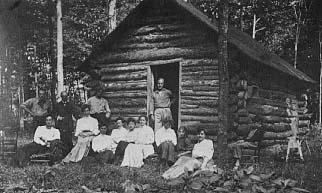
At a Roycroft Institute Picnic
|
By 1901, the Roycroft Institute was offering furniture through mail-order catalogues. Hubbard claimed that each piece of furniture was made-to-order, reflecting the Arts and Crafts Movement's philosophy of individual styles and hand-made goods. However, this is considered to be highly unlikely given the types of machines in the Roycroft shops and given that they employed over 400 people. Despite this implausible claim, Hubbard was considered to be a smart businessperson with a good marketing scheme (Anscombe pg. 67).
The Roycroft Institute was a true artist community. Although many local residents from East Aurora were employed there, an even greater number came from elsewhere to find work. Roycroft developed an apprentice system where workers could learn various crafts, moving from one shop to another. The cultural life of the community included lectures by Hubbard, which could be read in the Fra, another influential publication of the Roycroft Press. The Fra was used as a marketing tool for the Roycroft products and as an avenue where Hubbard could preach his Arts and Crafts beliefs.
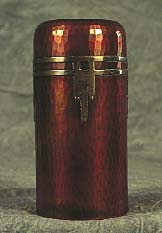
Roycroft Copper and
Silver Vase, c.1901
Accession # M969.13.95
|
Karl Kipp, the foreman of the metalwork shop, had a long lasting influence over the Roycroft copper shops. Kipp conceived of most of the metalwork designs himself before turning the manufacturing over to the one of the many craftspersons. Kipp left the Roycroft Institute in 1912 to begin his own metalwork studio called the Tookay or two k's from his initials.
Dard Hunter was another individual who influenced the styles produced at the Roycroft Institute. Hunter joined the Roycrofters in 1901 and worked at designing furniture, metal objects, leaded glass and books. In 1908, Hunter went to Vienna to study Viennese styles in arts and crafts. Hunter is said to have influenced Karl Kipp's introduction of Viennese influences in many of the Roycroft metalwork designs.
In 1915, Elbert and Alice Hubbard perished on board the Lusitania . Their son Bert took over the Roycroft business. He persuaded Karl Kipp to return to his former position in the metalwork shops and established Roycroft departments in hundreds of stores across the United States . |
The Roycroft Institute became victim to the depression and was sold off in an auction in 1938. For his time, Elbert Hubbard, who was neither an artist nor a designer, can be considered a good businessperson. His personality is said to have drawn people to the Roycroft merchandise and keep the Roycroft community together ( Clark , pg. 45). Hubbard was the first to use mass advertising to influence the styles and purchases of the middle class in North America and beyond. And, Hubbard remained true to the philosophy, if not always the practice, of the Arts and Crafts Movement.
The Roycroft Institute has left a large legacy. Each Roycroft piece was inscribed with either an orb or a cross, which Hubbard chose as the Roycroft symbols, or with the Roycroft name. Each piece of metalwork was inscribed with a capital R within a circle, topped with a cross. It is estimated that tens of thousands of pieces were produced in the Roycroft Institute between 1908 and 1938. Since Hubbard insisted that each piece carry the Roycroft insignia, and not that of the individual artists', the Roycroft mark is one of the best known shopmarks in the American Arts and Crafts Movement. Only a very few of the metalwork pieces contain the insignia "KK" of Karl Kipp. |
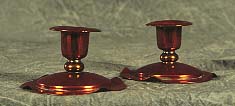
Roycroft Copper Candlesticks, c.1905
Accession # M969.13.37 A-B
|
The metalwork of the Roycroft Institute became increasingly popular while furniture and other large items diminished in importance. This increase in popularity for metalwork was due to the desire of consumers who came to East Aurora for smaller, more portable souvenirs. Copper was the most widely-used metal in the Roycroft metalwork shops. Copper pieces were usually decorated using brass and silver.
Rookwood Pottery
Cincinnati in the late 1800's is where the American Art Pottery Movement established its foundation. The Rookwood Pottery and later Rookwood Pottery Company, had a long tradition in the Cincinnati area as one of the most successful pottery companies in the United States in its time.
The Rookwood Pottery was founded by Maria Longworth Nichol, the granddaughter of Cincinnati real-estate millionaire, Nicholas Longworth. With the assistance of her father, Nichol established her own pottery in an old schoolhouse in 1880 and named it after their family estate.
Near the turn of the century, pottery was considered an acceptable profession for socially prominent women. Nichol organized clubs of women who handpainted pottery and attended the Rookwood School for Pottery. Married with Nichol's personal interest in the development of pottery as an art form, was her belief that it could also be a commercially viable business ( Clark , pg. 119).
In a few short years from the birth of the Rookwood Pottery, the success of the business grew. By 1881, the Rookwood Pottery had produced several thousand pieces and would be a dominating force in the pottery market. A line called "Standard Ware" became extremely successful and made Rookwood a household name among middle-class America .
Right from the early years, Nichol found that the administrative responsibilities of the pottery were overwhelming and hired a businessperson, William Taylor, to run the company in 1881. Taylor hired Albert Valentien, who was Rookwood's first regularly employed member of the decorating staff, which began the change from independent studios of amateurs to professional staff of decorators ( Clark , pg. 119).
The pottery of Rookwood became even more commercially successful with recognitions such as a gold medal at the World's Fair in Paris in 1889. Soon after this medal was awarded to Rookwood, Nichol transferred her interests in the Pottery to Taylor , knowing that it would continue with its successes. |
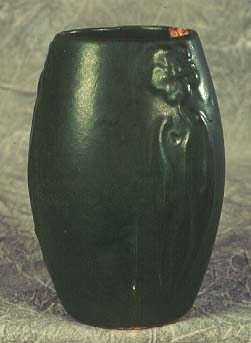
Rookwood Ceramic Vase, c.1900
Accession # M969.5.3 A-B
|
In several ways, Rookwood Pottery reflected the Arts and Crafts Movement's philosophy. It tried to create a pleasant working atmosphere for its craftspeople and initially encouraged individual creativity and freedom. In an essay published by the Bohemian Guild of the Industrial Art League of Chicago in 1902, Rookwook is described as "an ideal workshop" (Triggs, pg. 157). In the essay which preaches against the ills of machinery and profiteering, Rookwood Pottery is considered to: ...[have] a soul. A woman's intelligence and affection went to its upbuilding...The motive that controlled the enterprise from the beginning was the desire to produce a perfect product. Below this must have been the intention to perform a social service in perfecting a given product...the fullest possible freedom is given to the workmen; they are encouraged to experiment, to express their individuality...the spirit of the factory is that of co-operation and good fellowship (Triggs, pg.s 159-60).
Rookwood Pottery is said to have reflected some of this persona of the Arts and Crafts Movement, partly because of the fact that in the beginning, women ran the Pottery. However, even from the very beginning, Nichol admitted that the reason for starting the Pottery was for her "own gratification" (Callen, pg. 81). In fact, a major reason why she hired women was that they could be paid less than men (ibid., pg. 81).
Once William Taylor took full control of Rookwood Pottery and renamed it the Rookwood Pottery Company, he closed down the Rookwood School of Pottery and disallowed the Pottery club which was a foundation piece of the Rookwood Pottery. He is said to have not tolerated the use of the company as an "outlet for genteel ladies with artistic leanings" (Callen, pg. 81). Taylor immediately started to replace many of the women with men. However, due to the fact that many of the women were truly talented and contributed greatly to the company and that they were much cheaper to employ than men, Taylor consequently kept many of the women at the company.
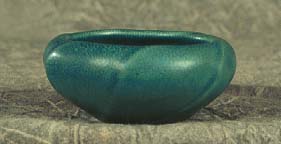
Rookwood Ceramic Pot, c.1890
Accession # M968.2.2
|
If it was not evident before, it was certainly evident after Taylor took the reigns of Rookwood; commercial success and profit were the company's focus. Despite this drive for commercial success, Taylor engaged in many publicity campaigns to try to align the image of the company closer to that of the philosophy of the Arts and Crafts Movement. Propaganda about the needs of artists before shareholders and artistic freedom were common from the Rookwood Pottery Company. |
However, the goal of commercial success remained and by the 1890's Rookwood began standardizing production to increase productivity to meet the great demand for the pottery pieces. For the most part, mould casting replaced hand-thrown wares. The company even experimented with lines of mass produced goods under different labels, but these were not a success and were quickly abandoned.
Technical advances such as an atomizer and a machine to remove air bubbles in clay helped in Rookwood's ability to produce more wares at lower costs. To continue commercial success, Rookwood also took a change in their approach to marketing by following the market and reacting to people's trends instead of leading the styles and tastes of consumers.
Although to this day, Rookwood is considered one of the foremost potters at the time of the turn of the century, it is acknowledged that the complete abandonment of the Arts and Crafts Movement's principles of high quality and artistic freedom to one that was more commercially oriented resulted in wares that in the end, did not match the quality of the earlier Rookwood Pottery pieces (Clark, pg. 120).
Tiffany Glass and Decorating Company
Son of Charles Tiffany, the famous owner of the New York jewellery company, Louis Comfort Tiffany is considered to be "the foremost American designer of art objects and decoratives" at the turn of the century ( Clark , pg. 19).
Tiffany was greatly influenced by the philosophy of the Arts and Crafts Movement and the works of William Morris, whom he visited while in Europe in 1867. Although he started as a painter, Tiffany became attracted to the art of stain glass making. He experimented with this art and, by 1876, had created his first art window.
In 1879, Tiffany established the Louis C. Tiffany and Associated Artists company in New York . Although this was a short-lived venture, he worked with many great artists such as de Forest , Colman and Wheeler. The company worked within the philosophy of the Arts and Crafts Movement and the writings of William Morris. They focused on quality and individual freedom to be creative.
By 1883, Tiffany had moved onto his passion of glassmaking. He established a company called the Tiffany Glass Company which made stain glass windows and mosaics, tiles and glass plaque pieces for architectural detailing. To reflect the growing and changing business, Tiffany changed the name of his company in 1892 to the Tiffany Glass and Decorating Company. By the 1900's, the Tiffany Glass and Decorating Company had reached their peak and added to their line metalwork, enameling and brass. In 1904, Tiffany introduced a new line of pottery.
In 1895, Tiffany added to his glass products of windows and vases by introducing the first leaded glass lamps to be sold to the public. Tiffany used many different glass making techniques influenced by works of Emile Galle and his own collection of Roman and Middle Eastern glass. He even developed his own styles such as the Cypriote and Lava.
True to the Arts and Crafts Movement in many ways, Tiffany was appropriately nationalistic and encouraged the use of American materials in the goods produced in his company. He also had an interest in American First Nations' art and this interest is reflected in some of his stain glass pieces. Tiffany loved nature and used floral and natural designs in his works often. He used bright, vibrant colours and kept approximately 200 to 300 tons of glass in his factory with approximately 5000 different colours and types ( Clark , pg. 24). |
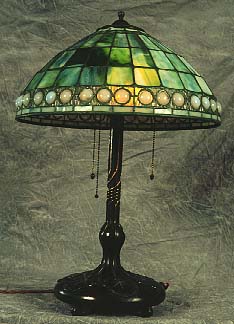
Tiffany Stain Glass Lamp
Accession # M968.7.1
|
The most significant part of the Arts and Crafts philosophy which Tiffany adopted was the belief in high quality, hand made goods. Unlike the more socialist leanings of the English proponents of the movement, Tiffany believed in high quality, hand made goods made in large scale proportions. In this way, Tiffany did succeed in fulfilling another Arts and Crafts Movement philosophy of bringing art to the masses. Because the diversity of products and their large-scale production, Tiffany produced items that ranged from very affordable to exclusively for the upper class.
Tiffany was dedicated and committed to perfection in his work. Although most of the work was left to individual craftspeople, Tiffany carefully supervised the manufacture of every piece from start to finish. He organized craftspeople of various trades under one roof in a large factory. He educated his workers on his art and trained his own apprentices.
In 1902, the name of the company was once again changed to Tiffany Studios. This marked a more commercial phase of the company's history. To keep up with the demand for Tiffany products and stay economically viable, Tiffany Studios began to develop many pieces using the production line method. However, because workers were still free to choose the colours of glass as they pleased, each piece did look original and it was difficult to discern which pieces were hand made and which pieces were made on the production line.
Despite their popularity at the time and their recognition for quality in the present day, the Tiffany Studios were not immune to the depressed economic climate of the last 1920's. In 1932, the Tiffany Studios, which was operating without the retired founder, declared bankruptcy. The legacy, however, continues to this day.
Architecture in Victoria 1880-1920
The Late 19th century experienced a movement in architectural styles against traditional high Victorian architecture to one that "advocated vernacular expression, the' honest' and natural use of materials and fine craftsmanship instead of mass produced parts" (Kerr, pg. 6). The Arts and Crafts Movement, which this became to be known, had its roots in England and had a great influence on architecture in North America between 1880-1920.
The Arts and Crafts architectural styles were being driven by British architects such as C.F.A. Voysey and Edwin Lutyens. The houses of the Arts and Crafts Movement were "wonderfully informal and unpretentious, sophisticated in a very subtle way" and designs suggested handcraftsmanship and a "harmony with the setting" (Maitland, pg. 164).
The writings of William Morris and John Ruskin which were widely publicized in North America , advocated for the Arts and Crafts Movement's beliefs in the use of nationally indigenous architectural styles and materials. Architecture was to compliment the environment, be simple and functional and of the best quality.
The leading two architects of the late 19th century and early 20th century in Victoria were Francis Rattenbury and Samuel Maclure. Whereas Rattenbury established himself as the foremost designer of institutions, Maclure become the foremost architect of residential homes. Maclure's early years in Victoria exemplify his deep connections to the Arts and Crafts Movement.
The area of Rockland in Victoria in particular contains numerous examples of the Arts and Crafts homes that were built in the time around the turn of the century. The Rockland area was developed in the early 1880's from a 500 acre Douglas Estate called "Fairfield Farm". The intention of this subdivision was to develop a prestigious neighbourhood (Segger, 1996).
Samuel Maclure had many commissions in the Rockland area and many of his Arts and Crafts homes still remain to this day. Two types of Arts and Crafts styles are particularly evident in the Rockland area. These include the sloping hillside slope and the chalet house style (Segger, Industrial..., 1989, pg. 11a).
Samuel Maclure ; Arts and Crafts Homes of Samuel Maclure
Alexis Martin Residence
Bigerstaff Wilson Residence
Roderick Finlayson Residence
Walter Nichol Summer Residence
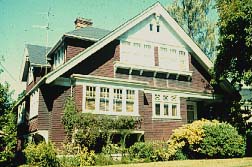
A "Pure" Shingle-Style Chalet House
|
Samuel Maclure (1860-1929) was born of Scottish Immigrants in New Westminster , British Columbia . From his early years, Maclure showed an interest in art and attended the Spring Garden Institute in Philadelphia from 1884-85. While at the institute, Maclure developed an interest in architecture and in the late 1880's returned to New Westmister and joined a local architectural practice. In 1892, he moved to Victoria and opened a practice of his own. |
For nearly 20 years, Maclure dominated residential architecture in Victoria . He is said to have been "probably the most notable of Victoria 's architects for both the quality and originality of the work that stemmed from a 40 year practice in British Columbia (Segger, Victoria..., 1979, pg. 340).
Within 10 years of establishing his own practice, Maclure had become the most successful domestic architect the area. Although he was successful throughout British Columbia and Washington State , most of his commissions were in Victoria .
Maclure was enchanted by the Arts and Crafts Movement and developed his own architectural styles based on that philosophy. His designs were "sensibly conceived, harmonious structures" (Bingham, pg. 7). His earlier works in Victoria remain truest to the Arts and Crafts styles. Maclure houses had many trademarks which made them distinct. These included broad hipped roofs with flaring eaves, frequent use of stone and distinctive picture windows, always facing a view. Interior features included an oak or fir-pannelled central hall and extremely high quality handcrafted detailing.
In his early years, Maclure developed the "Maclure bungalow" style which were sturdy one story buildings, wood-framed and surfaced in shingles. These houses were "practical, handsome and inexpensive" (Eaton, pg. 3). In these years where Maclure aligned himself with the Arts and Crafts Movement, his houses show evidence of the architect struggling to find "an architectural form expressive of the environment and its population" (Segger, 1986, pg. 79). He did develop a style which was distinctly Arts and Crafts and distinctly his own.
In keeping with the Arts and Crafts tradition, Maclure believed in the individual and custom designing each home. No two homes of Maclure are said to be the same. Although clients often requested homes that resembled his existing work, Maclure refused to comply because he believed that each house must be unique to the needs of each client (Bingham, pg. 58).
In designing these original homes, Maclure worked closely with the wives of the household. The society wife was considered the "arbiter of taste" and Maclure had a natural ability and sensitivity to establish congenial working relationships with these women (Segger, 1996).
Maclure kept apprised about the current Arts and Crafts styles by subscribing to several prominent architectural journals which featured the latest works of Arts and Crafts architects such as Voysey, Baillie-Scott and Lutyens. Voysey, in particular, had a great impact on Maclure's designs. Maclure adopted many of Voysey's trademarks such as the use of half-timber and open galleried central halls.
By 1903, the Voysey influence was quite evident in Maclure's work by the transformation of Maclure's earlier colonial bungalows to ones with larger roofs, more simplified forms and vestigial buttresses. By 1912, "Maclure was not adverse to producing residences which must be almost literal interpretations of the Voysey manner" (Segger,1996).
Maclure was also fascinated by the works of Frank Lloyd Wright with whom he corresponded (Bingham, pg. 5). Wright's influences on Maclure are evident in the floating roof planes and rigid geometric handling of timber in many of his designs.
Maclure's involvement in the Arts and Crafts Movement was not restricted to architecture. In 1890, Maclure had begun giving watercolour painting lessons which enabled him to socialize with the best of Victoria 's society. He took this opportunity to give lectures on the Arts and Crafts philosophies and writings of such proponents of the movement as William Morris.
In 1909, Maclure became one of the founding members of the Vancouver Island Arts and Crafts Society. As the cream of society, it greatly influenced the tastes and styles of the families on the island (Segger, Industrial..., 1979, pg. 17). |
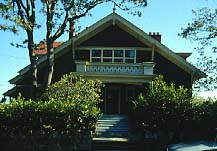
Chalet Style Arts & Crafts House
|
Maclure reached the high point in his career between the years 1900 and 1914. During this time, he popularized the English half-timber home which is now a unique characteristic style of Victoria (Segger, 1996). Many of Maclure's designs were published in prestigious international journals such as the Craftsman, The Studio and Country Life.
Although Maclure moved away from the Arts and Crafts style in his later years, the impact of his Arts and Crafts designs on Victoria were substantial. He developed a style which now typifies residences in Victoria in the time of the turn of the century and, "if today, the city has a reputation as the most English place in Canada, it is due in no small measure to the half timber idiom which [Samuel Maclure] popularized" (Eaton, pg. 5).
The Alexis Martin residence located in the prestigious Rockland area is considered to be a landmark in the career of architect Samuel Maclure . Designed in 1904 for the family of lawyer Alexis Martin, the house is representative of Maclure's pure Arts and Crafts designs. In its day, the house attained "international acclaim as an exemplary Arts and Crafts residence" (Segger, 1986, pg. 53).
Featured in two prestigious international publications, the Craftsman and the Canadian Architect and Builder, the chalet shingle-style house extends horizontally over the landscape with its wide weeping gable and west end sun room ( Victoria , pg. 62). |
Alexis Martin Residence
|
The house is clad entirely in cedar shingles which were allowed to weather naturally. The extended west-side verandah gives a more horizontal effect to the home, which combined with the mixture of half-timbering, single and plastic handling surfaces, hints of Maclure's earlier bungalow style homes and the work of Wilson Eyre, whose works Maclure became familiar while studying in Philadelphia. Despite these influences, the residence remains distinctly Maclure (Segger, 1986, pg. 112).
True to the Arts and Crafts Movement, the textures and spatial design of the residence makes it seem like it is an extension of its natural environment. A Maclure trademark is to ensure a picturesque window with a fabulous view and the Martin drawing room and porch open up to spectacular views of the Olympic Mountains and the Juan de Fuca Straight.
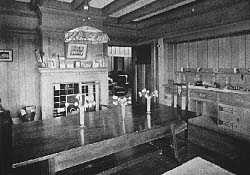
Interior of Alexis Martin Residence
|
The interior of the residence was furnished by the famous Arts and Crafts interior designers, M.H. Bailley-Scott and Gustav Stickley which highlights the Martin family's awareness of and preference for top quality Arts and Crafts furnishings. Throughout the residence, "there was an emphasis on simplicity and lightness" (Bingham, pg. 62).
The arrangement of the interior space allows for the hall to be the spatial core of the house, functioning as a central living room. All rooms are panelled in natural fir with matching heavy ceiling beams. The panelling of the first floor was stained a dark brown while the upstairs was finished with white plaster. Large tiled fireplaces graced each room as centre pieces. |
The Alexis Martin house is a classic example of the fascination with the Arts and Crafts styles in Victoria around the turn of the century and the mastery of Maclure to create a style true to the movement yet distinctly his own. The Martin house is "perhaps Maclure's most celebrated design during his own lifetime" (Segger, 1986, pg. 111).
Biggerstaff Wilson, a son of well known clothiers from England , commissioned a home from Samuel Maclure in 1905. Wilson, who had an ice and cold storage business, made his fortune from an inheritance from his namesake, a wealthy, family friend who was a bachelor. The Wilson home, located on prestigious Rockland Avenue , is considered to be Maclure's "most successful and powerful Tudor Revival residence" ( Victoria , pg. 64).
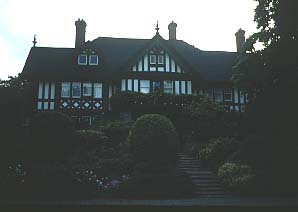
Bigerstaff Wilson Residence
|
One of Maclure's first and finest large Elizabethan Revival timber style manor houses, the Wilson house represents Maclure "at the height of his Medieval Arts and Crafts period" (Segger, Victoria..., 1879, pg. 301). Although the house has a strong Tudor flavour, it projects an asymmetrical effect. |
The first level of the Wilson residence is composed of irregular masonry which was a favourite material of Maclure. Above this Maclure used white stucco rectangles and dark woodwork in his exterior design.
The half-timber elevation of the house is dominated by a massive roof and gabled entrance bay. Random ashalar on the first floor blends with the surrounding rock gardens, creating an atmosphere true to the Arts and Crafts style of harmonizing the house with its natural environment.
The Elizabethan revival scheme is not continued to the rear of the home. Instead, it is replaced by shingled wall surfaces and flat and hipped roof dormers.
Maclure always tried to ensure that the residents of his homes were privy to spectacular views. In the Wilson home, the south porch opens into the garden and the balconies on the second floor and the entrance provide breathtaking views of the landscaped grounds.
The interior of the Wilson residence is equally tasteful and demonstrative of the belief in high quality handcrafted work of the Arts and Crafts Movement . In the Wilson home, Maclure created a stately mansion complete with a grand baronial hall, richly panelled with unpolished local woods and complimented with delicately patterned art glass.
The large central hall of the Wilson residence is galleried on three sides and lit by a collection of art-nouveau leaded windows on the fourth. This hall, which contains a large fireplace, is treated as a living room and considered one of Maclure's "most successful halls where the handling of light, space and architectural detail combine to produce an almost sculptural quality" (Segger, 1986, pg. 134). On a sunny day, this hall is filled with a beautiful array of controlled light. |

Garden Along the Driveway
|
One of the main features of this house is the staircase whose divisions are marked off by vertical elements with a strongly sculptural character. This wood detailing on the staircase is continued through and around the fireplace.
With the Wilson residence, Maclure set the standard for gracious living in Victoria . This style would be emulated by the upper class in Victoria for the next decade (Segger, Victoria..., 1979, pg. 301). This house is representative of Maclure's prewar phase which is "generally considered to be his most innovative and vigorous period" (Mills, pg. 376).
To this day, the Wilson residence remains in use as a single-family dwelling. Neither the interior or exterior have undergone significant changes. The original garden scheme also remains intact and therefore, this house is considered one of Maclure's "most impressive surviving houses" (Segger, 1986, pg. 134).
Built in 1914 for Roderick Finlayson, son of one of the founding families of Victoria , the Finlayson residence on Beach Drive had the best fronting onto Willows Beach . Considered to be one of Maclure's "most imgainative and exquisite designs", this residence is evidence of the English school influence on architect Samuel Maclure .
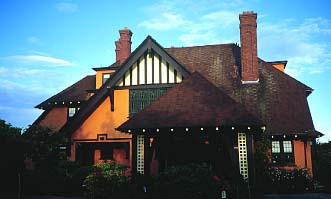
Roderick Finlayson Residence
|
When Finlayson approached Maclure to commission a house, the war had already begun and business was slow for Maclure so he had a generous amount of time to carefully plan and design this Tudor style residence. The location of the home on the beach front, metres from the seashore, could not have been more perfect. |
The exterior of the residence is featured by a massive bungalow roof, hipped with extensive spreading eaves. The foundation is laid with bricks which are continued to the lintel height on the seaward gabled bay. A sheltered porch between the two facade bays lead out into a terraced garden which stretches to the seashore.
The grounds on the Finlayson residence were extensive and covered four lots. As always, Maclure ensured that picturesque windows were carefully placed to ensure that residents enjoyed the best views from their home. From the Finlayson seaside windows, there were spectacular views of Mount Baker and the Strait of Georgia .
The interior of the Finlayson residence reflects some of the characteristics of the designs of Voysey and Baillie-Scott. However, the interior is "characteristically Maclure" (Segger, 1986, pg. 148). The entrance is through a tiled vestibule to the main hall, which have always reflected Maclure's tradition of excellence.
The woodwork of the interior is milled, turned and joined cabinetry. There are beamed ceilings and spindles of staircase and gallery railings lead out to the half-timbered gallery walls. The effect of the polished dark grained fir "introduces a baronial splendor, typical of Maclure" (Segger, 1986, pg. 148).
In the Finlayson residence, there is also a "fragility of detailing" which is absent in almost all of his other works . The hallways is "romantically suffused" in light from art glass windows (Segger, 1986, pg. 148). |
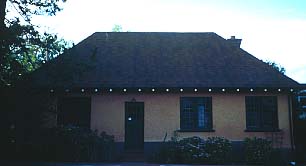
Garage of the Finlayson Residence
|
This design of Samuel Maclure is one of his "finest and most personal architectural statements" (Segger, 1986, pg. 148). In this creation, Maclure has combined the stylistic themes he pursued during the last 14 years of his practice. The Finlayson home was one of the last designs of Maclure's in the Arts and Crafts tradition .
In 1925, the Lieutenant-Governor of British Columbia , the Honourable Walter C. Nichol commissioned Samuel Maclure to build him a summer home in a wooded rocky property in Sidney . Nichol and his wife were "noted patrons of the arts" and were very personally aware of the former successes of Maclure's designs (Mills, pg. 538).
Nichol served as president of both the B.C. Art League and the Arts and Crafts Society of Victoria . This interest in the arts and, in particular with the Arts and Crafts Movement, "culminated in 1925 when [Nichol] commissioned Maclure to design a new summer residence on the Saanich Peninsula, 18 miles north of Victoria" (Mills, pg. 538). |
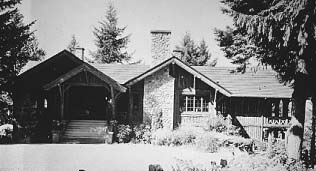
"Miraloma"
|
Considered Maclure's "most powerful rustic-style design of his career", the residence, which was named "Miraloma", was one of Maclure's last really large commissions yet one that really expressed his originality in design (Segger, 1986, pg. 204). Although by this time Maclure had drifted away from formal Arts and Crafts designs, the designing of Miraloma revitalized this former passion.
Miraloma was sited on several acres of beautifully landscaped gardens overlooking the sea. Only local materials were used in the construction of the house to create the essence of the house becoming a part of the land and surrounding woods. The house was an "extraordinarily powerful statement in wood" with the exterior composed of rugged slabs of Douglas fir with the bark unremoved (Eaton, pg. 24)
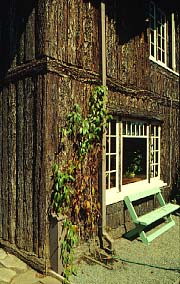
Exterior of "Miraloma"
|
Nichol had specifically asked Maclure to use BC woods in the construction of the house so that the house would express a local character. An atmosphere of harmony with nature was achieved in Miraloma with a controlled approach so that visitors gradually left urbanization behind as they approached the residence (Bingham, pg. 119).
At Miraloma, there were balconies and verandahs at both levels of the house which featured seaview and garden vistas. A unique feature of the home was the supporting posts of the balconies which were undressed firposts with Y-shaped braces. In all ways, the house resembled a tree which stretched both upward and outward.
The roof of the Nichol summer home was finished in dark red asphalt shingles which were matched by the interior tiles. In keeping with natural appearance, the exterior sash and carpentry details were painted vermilion green which also served as a nice contrast to the red-brown bark walls. Miraloma also sported large stone chimneys which gave an appearance of solidity of the structure to the earth. |
The interior design of Miraloma was a balance between rustic and cultural refinement. In the livingroom, a wall of undressed fir framed a huge fireplace which was done in cyclopean masonry. A variety of woods were used in the interior: fir, cottonwood, spruce and beech, which were stained to produce some "exceptional effects" (Bingham, pg. 120).
In keeping with the regional character of Miraloma, the interior of the home featured elements designed and constructed by local artists and craftspeople. The staircase displayed carved animals and the house was furnished with handmade First Nations' rugs while the dining table was decorated with painted First Nations' motifs.
In the design of Miraloma, Maclure truly achieved the goal of harmonizing the house with nature. "In the final design, the house and garden are indivisible" (Segger, 1986, pg. 204). Miraloma is unquestionably a testament of the creativity, brilliance and understanding of the environment that Maclure exemplified throughout his 40 year career. |
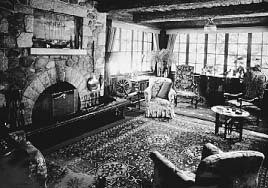
Interior of "Miraloma"
|
Miraloma remains in its original location to this day and it is currently serving as a restaurant.
Arts and Crafts Gardens in Victoria
By the late 1870's in Canada , proponents of full, natural gardens were delivering their message throughout the country. Aided by the writings of Gertrude Jekyll, a major horticultural figure in this time, neatly bedded and sparsely decorated gardens were being rejected for a more full, comprehensive garden which fused lawn, trees, shrubs and flowers into an "artistic whole, with nature as teacher and example" (von Baeyer, pg. 105).
Samuel Maclure, leading domestic Arts and Crafts architect in Victoria around the turn of the century, was greatly influenced by the gardens of Jekyll and formalized the classic English garden in Victoria . Maclure had a life-long interest in gardens and in the conserving of nature and, in particular, in the conserving of trees. It is said that when Maclure designed properties, he would go to great lengths not to have to cut down a single tree if it was not absolutely necessary (Segger, 1986, pg. 175). |
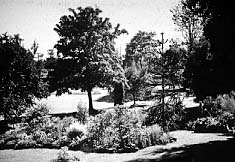
Garden at "Miraloma"
|
Maclure was also influenced by the earlier Arts and Crafts garden designs by Thomas H. Mawson which were included in his first publication, The Art and Craft of Garden Making in 1900. As a founding member of the Vancouver Island Arts and Crafts Society, founded in 1909, Maclure was involved in influencing civic beautification and was among the leaders in garden design.
The mild climate in Victoria and its long British tradition made it the ideal community for the growth of the art of gardening. The temperate climate made it possible to garden year round while the natural rugged environment contributed to development of Arts and Crafts gardens.
The turn of the century was a "watershed period for Victoria landscape design" (Segger, 1996). Private gardens were regularly open to the public, large scale nurseries were established and many publications, guides and catalogues were produced.
Gardens were very much an integral part of the social life of the middle and upper class in Victoria . To have a beautiful garden in the latest mode, using the proper furnishings was a "socially enhancing" activity which was considered to be at the utmost of civilization (von Baeyer, pg. 107). The garden was a reflection of its owner and if the owners of the property wanted to be seen as progressive and prosperous, so must the garden. |
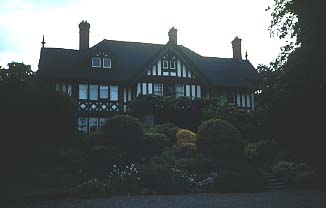
Garden at B. Wilson Residence
|
To designers such as Maclure, gardens completed and enhanced the natural environment. Gardens were seen as an extension of the living space of the house and not just an ornament. This concept of the fusion of house and garden was carried through to the need for fresh cut flowers to adorn the interior of the house in the Spring and Summer months.
The garden and house needed to create a sense of harmony and balance. The function of the garden as an extension of the residence was to assist in the transition from the natural environs to the exterior of the house to the interior.
The gardens that Maclure designed, despite financial and spatial constraints, needed to reflect the civilized and social standing of the owners. The Arts and Crafts garden had the appearance of a natural environment with the recognition that as a human construction, it needed careful planning and constant maintenance.
Maclure created gardens and designed properties using features of the natural surroundings to achieve the utmost feeling of consonance with nature. Flower beds, trellices and ivy were used in Maclure's gardens to make the transition from grounds to residence even more subtle.

View from "Miraloma"
|
The most published Arts and Crafts garden of Samuel Maclure was that of "Miraloma", the summer residence of Lieutenant-Governor William Nichol in Sidney , B.C. To this day, examples of Maclure's Arts and Crafts garden survive at homes such as the one built for Biggerstaff Wilson in the Rockland area.
Like in his architectural designs for his houses, Maclure's gardens "reflect the architect's same sense of spatial acuity, his penchant for the complex spatial inter-relationships, the subtle ensions between the formal and informal, constricted and open space" (Segger, 1986, pg. 177). |
By Maltwood Art Museum
|
|
|